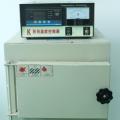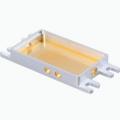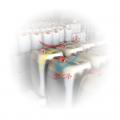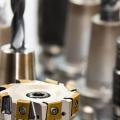The basic principle of degreasing and the precautions for electro degreasing and chemical degreasing
Greases are divided into two categories according to their composition and performance, namely mineral oils and animal and vegetable oils. These two types of oils are called saponified oils (animal and vegetable oils) and non-saponified oils (mineral oils) according to their ability to react with alkalis.
The main components of animal and vegetable oils are fatty oils, which react with alkali to produce water-soluble soap and glycerin, so they can be removed in hot alkaline water. The main source is polishing paste or grease contaminated in storage and hand touch.
Mineral oil and alkali cannot produce soap and other soluble chemicals, but they can be dispersed into very small oil particles by surfactants and become emulsions, so they can be removed by emulsification. These oil stains are cutting oils that may be used during machining or anti-rust oils between processes.
However, the surface of the product is often not simply a single type of oil, so most of the degreasing process uses a combined process to carry out comprehensive degreasing or stepwise degreasing. The main point is to completely remove the surface oil.
De-oiling is in the electrolyte with certain saponification and emulsification, the degreasing product is used as the electrode, and the large amount of hydrogen (cathodic electrolysis) and oxygen (anode electrolysis) generated in the electrolysis process are used to strengthen the deoiling process.
Since the effect of the evolved gas is mainly used, it is necessary to pay attention to the degreasing effect of different electrode performances while preventing side effects. First of all, for steel products, especially elastic parts, when using cathode degreasing, to prevent hydrogen embrittlement, it is best to use anode degreasing. Another side effect of cathodic degreasing is that electrodeposition of oil may occur. The degreasing liquid is required to be very clean, and there should be no metal ions that can be plated into it. Otherwise, it will seriously affect the electroplating quality, especially the bonding force.
For anode degreasing, because it is an oxidation process, for non-ferrous metals such as copper alloys, it is necessary to prevent anodic dissolution and damage the substrate. At the same time, passivation of the substrate may also occur at a certain potential, resulting in poor electroplating later.
In the chemical degreasing process, for non-ferrous metals, such as copper alloys, sodium hydroxide should be used less or not. For aluminum alloy and zinc alloy products, it is even more necessary to use less or no sodium hydroxide to prevent the occurrence of corrosion and damage to the product.
For the degreasing liquid containing water glass (sodium silicate), after degreasing, it must be fully cleaned in hot water to prevent the unwashed water glass from reacting with acid to form water-insoluble silica gel and affecting the coating. Binding force.







